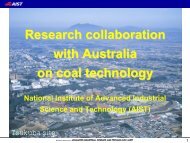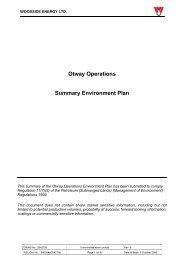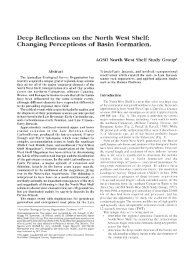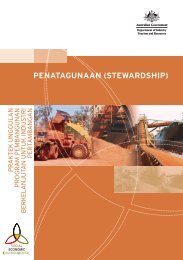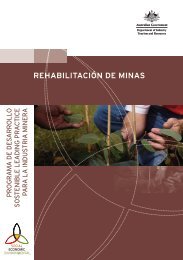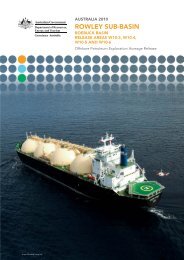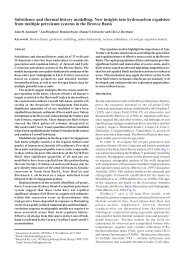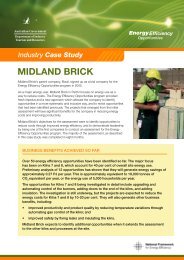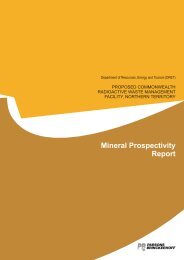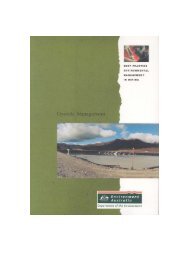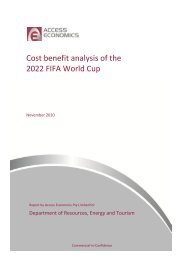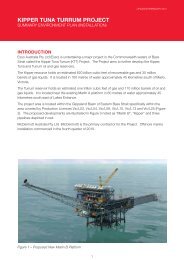A guide to leading practice sustainable development in mining
A guide to leading practice sustainable development in mining
A guide to leading practice sustainable development in mining
You also want an ePaper? Increase the reach of your titles
YUMPU automatically turns print PDFs into web optimized ePapers that Google loves.
tail<strong>in</strong>gs disposal techniques cont<strong>in</strong>ue <strong>to</strong> evolve such<br />
as <strong>in</strong> <strong>in</strong>-pit or thickened discharge methods<br />
the safe s<strong>to</strong>rage and handl<strong>in</strong>g of cyanide and other hazardous substances is now<br />
well established with much guidance material available for m<strong>in</strong>e management.<br />
Introduction<br />
M<strong>in</strong><strong>in</strong>g operations <strong>in</strong> Australia and <strong>in</strong>ternationally cover a range of commodities,<br />
sizes, and methodologies. The Australian m<strong>in</strong>erals sec<strong>to</strong>r is <strong>in</strong> the <strong>to</strong>p five producers<br />
of most of the world’s key m<strong>in</strong>erals commodities <strong>in</strong>clud<strong>in</strong>g<br />
The world’s <strong>lead<strong>in</strong>g</strong> producer of bauxite, alum<strong>in</strong>a, rutile, and tantalum.<br />
The second largest producer of lead, ilmenite, zircon and lithium.<br />
The third largest producer of iron ore, uranium, and z<strong>in</strong>c.<br />
The fourth largest producer of black coal, gold, manganese and nickel.<br />
The fifth largest producer of alum<strong>in</strong>ium, brown coal,<br />
diamonds, silver and copper (MCA).<br />
Australian m<strong>in</strong><strong>in</strong>g methods range from surface m<strong>in</strong><strong>in</strong>g that may <strong>in</strong>clude strip<br />
m<strong>in</strong><strong>in</strong>g with dragl<strong>in</strong>es; truck and shovel or conventional open pits; and alluvial or<br />
placer m<strong>in</strong><strong>in</strong>g, <strong>in</strong>clud<strong>in</strong>g dredg<strong>in</strong>g for m<strong>in</strong>eral sands, precious metals and gems.<br />
Underground coal m<strong>in</strong><strong>in</strong>g ranges from longwall and bord and pillar while cav<strong>in</strong>g and<br />
s<strong>to</strong>p<strong>in</strong>g methods are most common <strong>in</strong> hard rock m<strong>in</strong><strong>in</strong>g. Apart from “m<strong>in</strong><strong>in</strong>g”, this<br />
chapter will also highlight susta<strong>in</strong>ability issues associated with m<strong>in</strong>eral process<strong>in</strong>g,<br />
metallurgical operations and occasionally ref<strong>in</strong>ery operations.<br />
Each of these methods may result <strong>in</strong> significant potential impacts on the susta<strong>in</strong>ability<br />
of m<strong>in</strong><strong>in</strong>g operations and thus each operation demands the highest level of<br />
management skills <strong>to</strong> m<strong>in</strong>imise any negative impacts. This Chapter covers <strong>lead<strong>in</strong>g</strong><br />
<strong>practice</strong> <strong>in</strong> susta<strong>in</strong>ability dur<strong>in</strong>g the production or operations stage of the m<strong>in</strong><strong>in</strong>g cycle.<br />
It is dur<strong>in</strong>g this phase that the benefits or costs of the plann<strong>in</strong>g decisions implemented<br />
dur<strong>in</strong>g the earlier phases are realised. This is also the phase of m<strong>in</strong><strong>in</strong>g where the<br />
greatest potential impacts on the environment and the community occur.<br />
Airborne Contam<strong>in</strong>ants, Noise and Vibration<br />
A recent newspaper article (Safe, 2009) highlighted the issue of noise and its<br />
impacts, both real and perceived on the local community. The article detailed the<br />
recent formation of an anti-noise lobby group – Noise Watch Australia. One featured<br />
case <strong>in</strong>volved a retiree who moved <strong>to</strong> a heavily timbered block some distance from<br />
a capital city. A sawmill <strong>in</strong>creased its production <strong>to</strong> 24 hours, 7 days a week. In<br />
his words, “the noise drove us darn crazy” and consequently he sold up. Another<br />
compla<strong>in</strong>ant stated “the growth of noise <strong>in</strong> communities across Australia is still not<br />
recognized for what it is – another form of pollution that’s hav<strong>in</strong>g serious health<br />
impacts on many people”. The World Health Organisation was quoted <strong>in</strong> the article<br />
as say<strong>in</strong>g that up <strong>to</strong> three per cent of heart disease deaths, or more than 200,000<br />
globally, are due <strong>to</strong> long time exposure <strong>to</strong> chronic traffic noise.<br />
88 LEADING PRACTICE SUSTAINABLE DEVELOPMENT PROGRAM FOR THE MINING INDUSTRY



